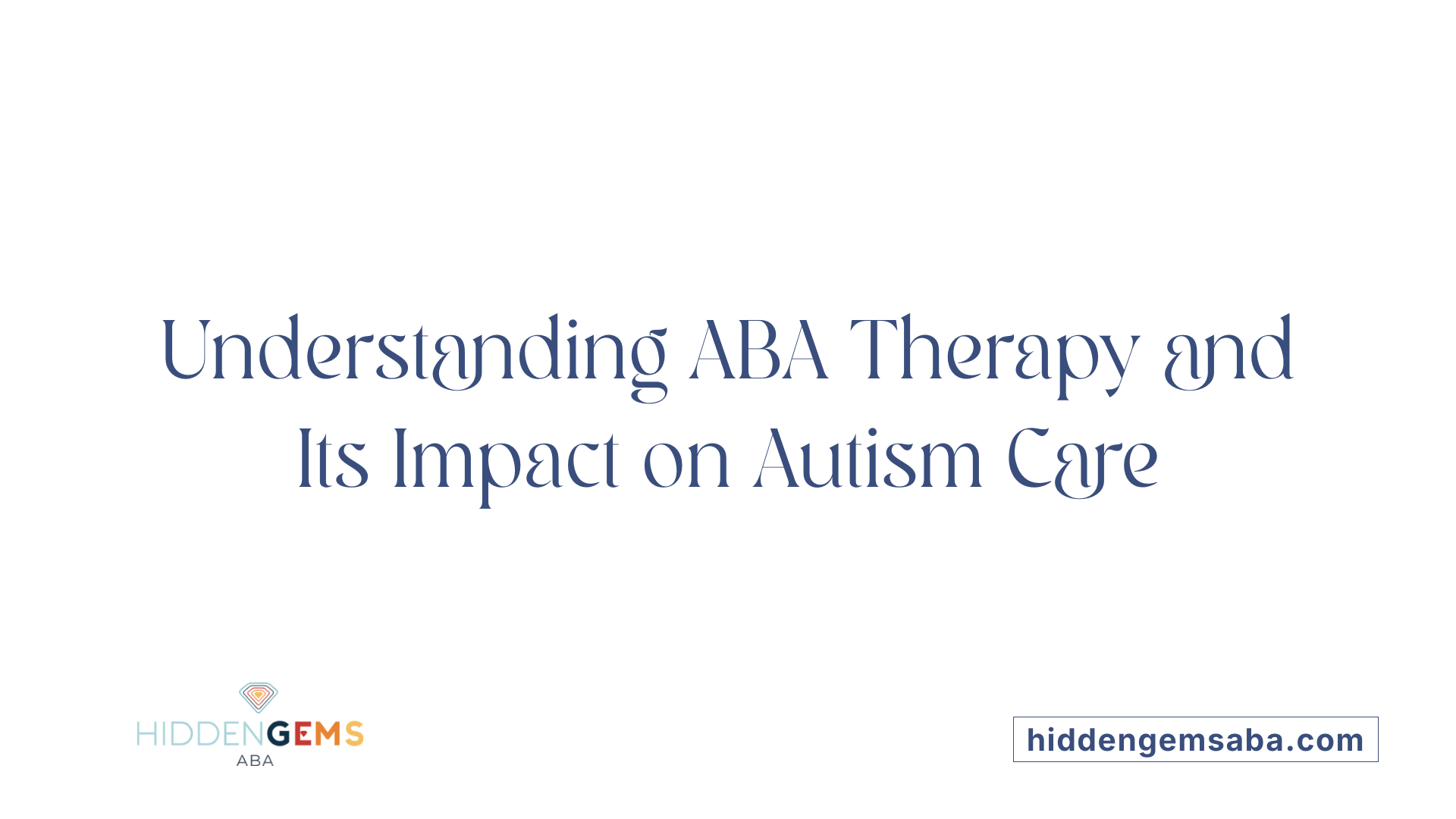Understanding ABA Therapy and Its Significance
Applied Behavior Analysis (ABA) therapy has emerged as a cornerstone in the treatment of autism spectrum disorder (ASD) and other developmental disabilities. Rooted in behavioral science, ABA offers evidence-based strategies designed to increase positive behaviors and reduce harmful ones, thereby enhancing communication, social skills, and daily functioning. This article explores the fundamental aspects of ABA therapy, its goals, the professionals involved in its delivery, and how progress is measured, providing a comprehensive view of its impact on developmental services.
What is Applied Behavior Analysis (ABA) Therapy and Its Role in Autism Treatment?

What is Applied Behavior Analysis (ABA) therapy and how is it used in treating autism?
Applied Behavior Analysis (ABA) therapy is a science-based method grounded in the principles of learning and behavior. It aims to increase helpful behaviors such as communication and social skills while reducing harmful or unproductive actions. ABA therapy is widely used to support children and individuals with autism spectrum disorder (ASD) by enhancing their language, social, academic, and daily living abilities.
What techniques are employed in ABA therapy?
ABA uses a variety of strategies centered on the ABC model: Antecedent (what happens before a behavior), Behavior (the action itself), and Consequence (what follows the behavior). Techniques include positive reinforcement to encourage desirable behaviors, prompting, and breaking skills into smaller, manageable steps. Specialized approaches such as Discrete Trial Training (DTT), Pivotal Response Treatment (PRT), and the Early Start Denver Model (ESDM) are used to tailor interventions according to individual needs.
How is the treatment approach individualized?
Each ABA program is designed based on comprehensive assessments conducted by Board Certified Behavior Analysts (BCBAs). These professionals develop detailed, personalized goals that address multiple skill areas relevant to the individual's progress. Treatment plans are regularly updated to reflect achievements and new objectives.
In what settings can ABA therapy be delivered?
ABA therapy is highly adaptable and can take place in various environments including the child's home, school, or community settings. This flexibility helps integrate learning across daily contexts, fostering generalization of skills.
What are the benefits of early intensive ABA intervention?
Scientific studies demonstrate that beginning ABA therapy early—particularly before age 4 with more than 20 hours per week—can lead to significant improvements in cognition, language, social abilities, and reduce the need for extensive future support. Early intervention maximizes developmental gains and promotes independence.
In summary, ABA therapy is an evidence-based, individualized behavioral treatment that plays a vital role in autism care. It blends scientific principles with tailored techniques to help individuals navigate challenges and thrive in their environments.
Key Goals of ABA Therapy in Supporting Individuals with Autism

What are the main goals of ABA therapy in autism treatment?
Applied Behavior Analysis (ABA) therapy aims to improve critical skills and reduce behaviors that may interfere with daily functioning for individuals with autism. Central goals include enhancing communication and language development. ABA helps children learn to effectively express their needs and engage in social conversations.
Social interaction is another targeted area, with therapy designed to foster meaningful relationships and improve social skills through natural reinforcement. Enhancing daily living skills, such as self-care and play abilities, also forms a core part of treatment to support greater independence.
Reduction of challenging behaviors that can negatively affect learning or social acceptance is carefully addressed using positive reinforcement rather than punishment. ABA focuses on increasing functional and socially significant behaviors, empowering individuals to participate more fully in family, school, and community life.
A hallmark of ABA is the individualized approach. Goals and methods are tailored based on detailed assessments by Board Certified Behavior Analysts (BCBAs), ensuring interventions meet each person's unique strengths, needs, and preferences.
Early intervention, especially intensive therapy before age four, is shown to yield significant developmental improvements. This supports long-term progress across multiple areas including communication, memory, attention, and academic skills.
Through these evidence-based, goal-specific strategies, ABA therapy helps individuals with autism achieve meaningful improvements foundational to their quality of life and independence.
Professionals Behind ABA Therapy: Qualifications and Roles

Who typically provides ABA therapy and what qualifications do they need?
ABA therapy is typically provided by trained professionals who have specialized expertise in behavioral analysis. The primary providers are Board Certified Behavior Analysts (BCBAs) and Registered Behavior Technicians (RBTs).
Qualifications for ABA therapists
To become a BCBA, individuals must hold at least a master’s degree in applied behavior analysis, psychology, education, or a related field. In addition to academic requirements, candidates complete supervised practical experience and must pass a certification exam administered by the Behavior Analyst Certification Board (BACB). Many states also require ABA therapists to have licensure, which involves additional application processes and exams.
Role of Board Certified Behavior Analysts (BCBAs)
BCBAs design, oversee, and evaluate individualized ABA programs. They conduct detailed assessments to determine clients’ strengths and needs, then develop treatment plans with specific goals across communication, social, academic, and daily living skills. BCBAs also supervise therapy sessions and adjust interventions based on progress and data analysis.
Training and certification requirements
Certification as a BCBA requires completion of approved coursework, logging supervised hours in clinical settings, and successfully passing the certification exam. For Registered Behavior Technicians, training involves focused coursework and supervision by a BCBA to implement ABA techniques directly with clients.
Settings where ABA therapists work
ABA therapies are delivered in diverse environments such as clinics, schools, homes, and community settings. The choice of setting depends on the client’s needs and goals, allowing flexibility to maximize effectiveness.
Tasks performed by BCBAs and Registered Behavior Technicians (RBTs)
BCBAs focus on assessments, designing intervention plans, supervising, and monitoring therapeutic progress. RBTs provide the direct implementation of ABA therapy by carrying out one-on-one sessions, using behavioral techniques like positive reinforcement and prompting.
ABA professionals apply evidence-based practices aimed at improving language, social skills, and adaptive behaviors to support individuals with autism spectrum disorder and related developmental conditions.
Measuring Progress in ABA Therapy: Data-Driven Outcomes

Systematic data collection methods
Progress in ABA therapy is continuously measured through systematic data collection. Therapists record specific behaviors as they happen, noting details like frequency (how often a behavior occurs), duration (how long it lasts), and latency (the time between a prompt and the behavior).
Tracking behavior frequency and duration
By tracking behaviors quantitatively, therapists can see clear patterns and trends. This measurement helps determine whether interventions are working to increase helpful behaviors or decrease harmful ones.
Use of graphs and reports
Data gathered is translated into graphs and reports that visually represent improvements or challenges. These tools are essential for behavior analysts (BCBAs) to monitor progress, compare outcomes over periods, and communicate results effectively.
Role of parent feedback
Parents provide critical feedback about how the child behaves outside therapy sessions. Their observations complement the data collected during therapy, ensuring that the program responds effectively to real-life situations.
Adjusting treatment plans based on data
Ongoing analysis allows BCBAs to adjust treatment plans promptly. If progress stalls or new challenges appear, data-driven insights guide changes to goals or teaching strategies, maintaining a personalized approach.
Use of SMART goals
Goals in ABA therapy are often structured as SMART goals—Specific, Measurable, Achievable, Relevant, and Time-bound. This framework ensures clarity in objectives and facilitates straightforward measurement of success.
Together, these methods create a robust system that keeps ABA therapy focused on meaningful, measurable outcomes for individuals with autism.
Innovative ABA Techniques and Therapies Enhancing Developmental Services

What is Discrete Trial Training (DTT)?
Discrete Trial Training (DTT) is a structured, one-on-one teaching method used in ABA therapy. It breaks down skills into small, manageable steps where each trial consists of a clear instruction, the child's response, and a consequence such as positive reinforcement. While DTT used to involve punishment techniques, current approaches focus solely on encouraging positive behavior through reinforcement.
How Does Pivotal Response Treatment (PRT) Differ?
Pivotal Response Treatment (PRT) is a play-based, child-led therapy that concentrates on the child's interests and motivations. Unlike the more structured DTT, PRT utilizes natural reinforcers, such as praise and play, rather than artificial rewards. This method aims to engage the child in natural learning environments and promote generalization of skills across settings.
What is the Early Start Denver Model (ESDM)?
The Early Start Denver Model (ESDM) is an ABA-based approach designed for young children, combining play-based and traditional ABA techniques. It targets multiple developmental goals simultaneously during activities and social play, fostering improvements in language, social skills, and cognitive functioning for children aged 12 to 48 months.
How Are Prompting and Reinforcement Used in ABA?
ABA therapy relies heavily on prompting techniques to help children engage with new skills. Prompts are gradually faded to encourage independence. Positive reinforcement is employed consistently to increase helpful behaviors and motivate learning, ensuring that skills are effectively acquired and maintained.
How Does ABA Adapt to Home and Community Settings?
ABA programs are highly adaptable and can be delivered in various environments including the home, school, or community settings. Strategies can be tailored for use by parents and caregivers to support ongoing progress outside therapy sessions, ensuring consistency and promoting generalization of skills.
How Are Play-Based and Traditional ABA Approaches Combined?
Methods like ESDM exemplify the integration of play-based and traditional ABA techniques. This combination allows therapists to engage children in naturalistic, fun activities while applying behavioral principles like reinforcement and analysis of antecedents and consequences. The blend supports comprehensive skill development in a motivating context.
These innovative ABA techniques offer diverse, personalized options to support developmental gains for children with autism, enhancing their communication, social engagement, and daily functioning.
Integrating ABA with Other Developmental and Behavioral Services
Complementary Therapies Supporting ABA
Applied Behavior Analysis (ABA) therapy is often combined with other developmental therapies for a comprehensive treatment approach. Occupational, speech, and physical therapies enhance ABA by targeting fine motor skills, communication, and physical coordination, supporting the child's overall development.
Psychological and Social-Relational Approaches
Alongside ABA, psychological methods such as cognitive-behavioral therapy (CBT) help manage co-occurring anxiety, depression, and other mental health issues in autism spectrum disorder (ASD). Social-relational approaches, including models like DIR/Floor Time and Relationship Development Intervention (RDI), focus on enhancing social skills, emotional connections, and community participation.
Pharmacological Support for Co-Occurring Symptoms
While ABA addresses core behaviors of autism, pharmacological treatments may be prescribed to manage symptoms like high energy, anxiety, seizures, or sleep disturbances. These medications complement behavioral therapies but do not target the primary symptoms of ASD.
Educational Models like TEACCH
Structured educational approaches, such as TEACCH, emphasize visual learning and classroom organization to support individuals with autism in academic settings. This method can be integrated with ABA to improve learning outcomes.
Importance of a Holistic Approach in Autism Treatment
A combined treatment strategy that includes ABA therapy alongside occupational, speech, physical therapies, psychological support, pharmacology, and structured education addresses the broad spectrum of needs in those with autism. This holistic approach aims to enhance communication, social interaction, motor skills, and emotional well-being.
Insurance Coverage and Accessibility Issues
Insurance coverage for ABA and related therapies varies, commonly including private insurance and Medicaid when medically necessary. Accessibility can impact service delivery, with some programs offered in clinics, homes, or hybrid settings to meet individual needs. Coordinated care across therapies ensures continual progress while addressing insurance complexities.
Looking Forward: The Future of ABA Therapy and Developmental Support
ABA therapy stands as a scientifically validated and versatile treatment approach that plays a critical role in enhancing the lives of individuals with autism and other developmental disabilities. Its individualized, data-driven methodology, coupled with the expertise of certified professionals, ensures meaningful progress across communication, social, academic, and daily living domains. By integrating ABA with other therapeutic and educational services, families and caregivers receive comprehensive support that addresses diverse needs. As research continues and accessibility improves, ABA therapy remains a hopeful cornerstone of developmental services, empowering individuals toward greater independence and quality of life.






